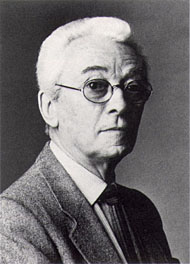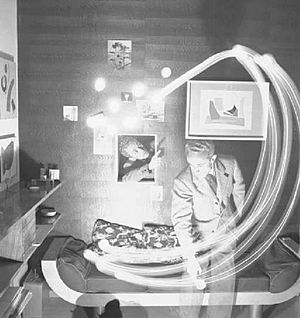Bruno Munari facts for kids
Quick facts for kids
Bruno Munari
|
|
|---|---|
 |
|
| Born | October 24, 1907 Milan, Italy
|
| Died | September 29, 1998 (aged 90) Milan, Italy
|
| Resting place | Cimitero Monumentale, Milan, Italy |
| Occupation | Artist, designer |
Bruno Munari (born October 24, 1907, in Milan, Italy – died September 29, 1998, in Milan) was a famous Italian artist, designer, and inventor. He made important contributions to many areas of visual arts, like painting, sculpture, film, and graphic design. He was also involved in non-visual arts, focusing on games, teaching methods, and how people learn through touch and movement.
Munari believed that art should be a part of everyday life. He once said, "Art shall not be separated from life: things that are good to look at, and bad to be used, should not exist." This means he thought beautiful things should also be useful.
Contents
Early Life and Beginnings
Bruno Munari was born in Milan but spent his younger years in Badia Polesine, where his family ran a hotel. In 1926, he moved back to Milan and started working with his uncle, who was an engineer.
In 1927, he became interested in the Futurist movement, which was an art movement focused on speed, technology, and the future. He began showing his own artwork in exhibitions. Later, he worked as a graphic designer, creating designs for magazines and books. During this time, he also started designing books especially for children, inspired by his own son, Alberto.
His Time with Futurism
Bruno Munari joined the Futurist movement in Italy in the late 1920s. During this period, he created collages for Italian magazines and made sculptures. Some of his ideas from this time, like his "useless machines" and abstract art, became important in his later work.
After World War II, Munari decided to leave the Futurist movement. This was because the movement had become linked to the political ideas of that time, which he did not agree with.
Later Life and New Ideas
In 1948, Munari and some friends started a group called Movimento Arte Concreta (MAC), which means the Italian movement for concrete art. Concrete art focuses on abstract shapes and colors, without trying to represent real objects.
During the 1940s and 1950s, Munari designed many everyday items for Italian companies. These included things like light fixtures, ashtrays, televisions, coffee machines, and even toys. He wanted to make useful objects that were also beautiful and well-designed.
Munari was also very important in creating children's books and toys. He had been making books for kids since the 1930s. He created books with different textures and cut-outs to help children learn about touch, movement, and colors. This way of learning, called kinesthetic learning, involves using your body and senses.
Bruno Munari passed away in Milan on September 29, 1998.
Munari's Books for Children
Bruno Munari wrote and illustrated many wonderful books for children. Here are some of them:
- The Elephant's Wish (1945)
- Bruno Munari's Zoo (1963)
- In the dark of the night (1961)
- The circus in the mist (1969)
- "What I'd like to be" (1945)
- Jimmy has lost his cap: where can it be? (1980)
- Who's there?: Open the door (1980)
- Romilda the frog (1997)
- The lorry driver (1945)
- Animals for sale (2004)
- From Afar it was an Island (2006)
- Drawing the sun
- Drawing a tree
Awards and Recognitions
Bruno Munari received many awards for his amazing work throughout his life:
- The Compasso d'Oro award for industrial design (1954, 1955, 1979)
- A golden medal from the Triennale di Milano for his "Libri illeggibili" (unreadable books) (1957)
- The Andersen award as the best children's author (1974)
- An honorable mention from the New York Science Academy (1974)
- A graphic award at the Bologna Children's Book Fair (1984)
- An award from the Japan Design Foundation for the human value of his design (1985)
- The Lego award for his great contributions to helping children develop creativity (1986)
- An award from Accademia dei Lincei for his graphic work (1988)
- An honorary degree in architecture from Genova University (1989)
- The Marconi award from the Brera Academy (1992)
- He was made a Cavaliere di Gran Croce, a high honor in Italy (1994)
- He became an honorable partner of Harvard University
Images for kids
See also
 In Spanish: Bruno Munari para niños
In Spanish: Bruno Munari para niños
- Industrial Design
- List of notable industrial designers
- Futurism




